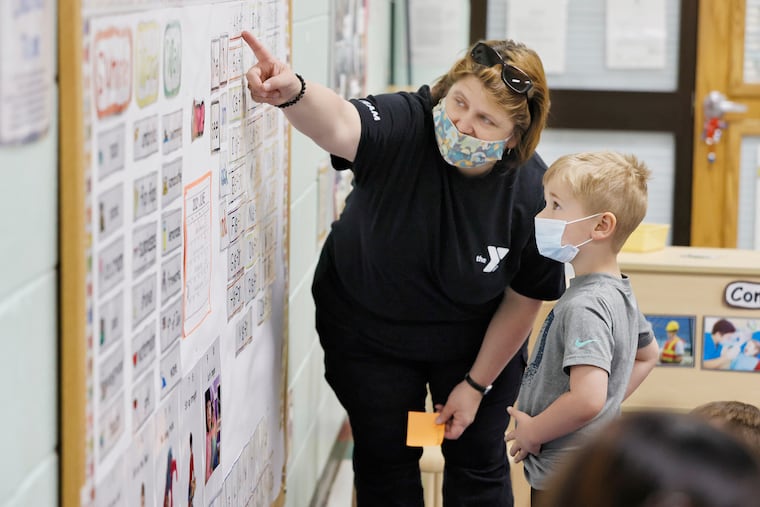Without enough child care, workers can’t get back to work
As the pandemic eases and businesses return to in-person work across the state, a large swath of parents hoping to rejoin the workforce are experiencing the same stress.

Alex and Kristine Schaffer are on seven waiting lists to get child care for their 6-month-old son, Oscar.
The couple, who live in Pittsburgh, are even looking outside their city at this point because they can’t seem to find a spot for their infant.
“We’re getting a range of wait-list dates,” said Alex, who just started a new job as a computer analyst and wonders how long he can rely on the kindness of his in-laws. “Some are in the fall. Some are saying ‘Talk to us next year.’
“I can’t imagine what single parents are doing in this environment.”
Across the state, as the pandemic eases and businesses return to in-person work, a large swath of parents hoping to rejoin the workforce are experiencing the same stress. What is happening in child care threatens the recovery of the U.S. job market, which has been slowed by a lack of workers, from restaurants and hotels to factories and construction companies.
At the Wonderspring Early Education child-care center in Narberth, the wait list runs 95 kids deep. While the center has had a wait list before, it is particularly bad right now, said Lisa Dugan, its director of communications and advancement.
A big reason for the wait lists is because of difficulties hiring qualified staff. Dugan says the shortage is due in large part to low pay: Child-care workers around the country make anywhere from under $9 in Mississippi to just over $15 in Washington, D.C., according to a 2019 study from the Center for the Study of Child Care Employment at the University of California, Berkeley. In Philadelphia, the hourly rate was $10.69.
Providers like Wonderspring and the YMCA of Greater Philadelphia have been having a hard time finding workers for their child-care centers.
Unlike other industries, child care isn’t able to just raise the workers’ wages, Dugan noted. Many organizations are nonprofit and cater to low-income families, whose child-care payments are often subsidized. These organizations’ margins, she said, are “razor thin.”
Because state child-care regulations set the maximum ratios of adults caring for children — for infants through preschoolers, it is one staffer for every four children — many centers haven’t been able to take on as many kids as they normally would.
Although the YMCA has yet to turn away families, it is currently hiring for 175 staff vacancies as part of a partnership with the Office of Children and Families at the School District in Philadelphia. That is not including hundreds of other vacancies for camp and child care they are also struggling to hire for.
Child care for young children is a critical part of their development. Numerous studies show that 84% of brain development occurs between birth and 5 years old, said Dugan.
The shortage of workers means that parents have had to stay home to watch their kids or think of other ways to get child care — like the Schaffers.
The United States, unlike some other developed nations, does not offer universal child care. As a result, funding isn’t always available to assist the workers, who are often women and women of color.
This summer, federal funding is set to come to Philly to assist families with child-care costs as well as nonprofits like Wonderspring. However, Dugan says federal money often comes with conditions on how it can be used, so organizations can’t always use those funds to boost their employees’ pay.
Throughout the pandemic, one of the largest groups of people who have left the workforce are women. The unemployment rate for women was 8.3% compared with 7.8% for men in 2020, according to the Department of Labor. Black and Hispanic women had the highest unemployment rates at 10.9% and 11.4%, respectively, exceeded only by Black men at 12.1%.
“A lot of mothers had to quit their jobs, basically to stay home. That’s the most economical strategy,” said Nancy Folbre, professor emerita of economics at UMass Amherst. “They couldn’t really call on grandparents to help out, for obvious reasons.”
Folbre, who looks specifically at families and child care, said the shortage has now led to gaps in seasonal workers and longer-term workers like teachers.
» READ MORE: Philly to lift coronavirus restrictions June 2 — nine days early — but keep indoor mask mandate in place
Even if people are passionate about kids, Dugan said, when money is tight and other places are offering higher wages, the workforce is going to head there and not to child-care centers.
“We are competing with places like Target or places like Amazon, in particular, that can afford to pay much higher rates and are offering like $1,000 signing bonuses,” she said. “We’re offering signing bonuses, but we still can’t begin to compete moneywise with them.”
Fill out this survey to share your thoughts on the Broke in Philly project.
The Philadelphia Inquirer is one of more than 20 news organizations producing Broke in Philly, a collaborative reporting project on solutions to poverty and the city’s push toward economic justice. See all of our reporting at brokeinphilly.org.